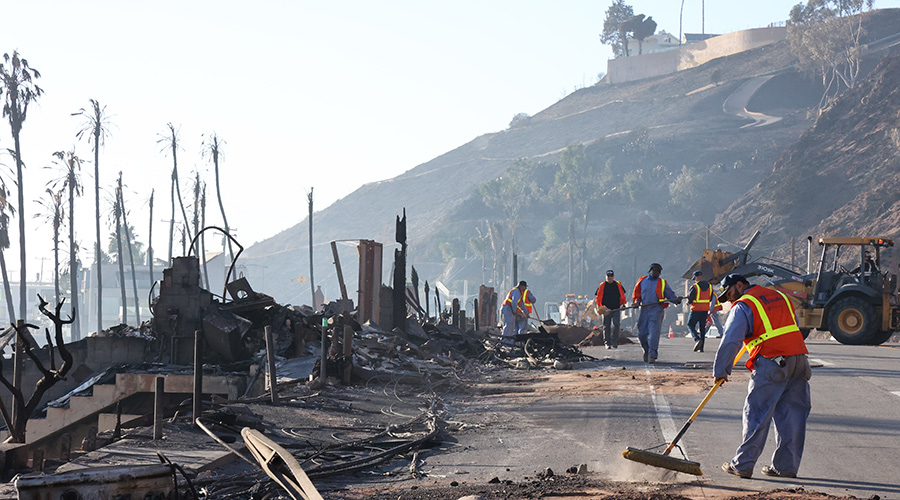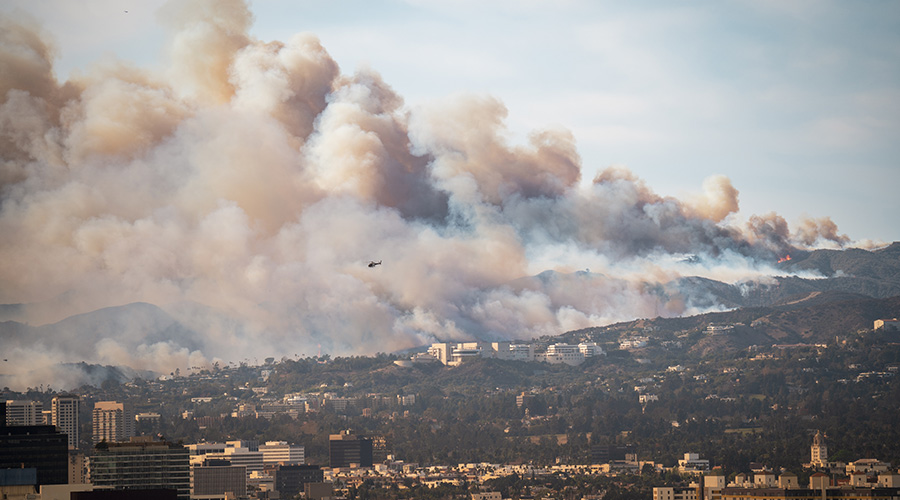Facilities Fight Fire with Preparation
Wildfire resilience is becoming a higher priority as the threat from flames and smoke moves closer to many facilities.
By Dan Hounsell, Senior Editor
Facility executives did not need much of a reminder that their buildings are under a growing threat from natural disasters. More dangerous and frequent hurricanes and droughts, for example, have led to greater emphasis in recent years and the need for enhanced resilience measures to ensure facilities are prepared for a crisis and can withstand and return to operations afterward.
Then came the massive and devastating California wildfires in early 2025. For any executives still uncertain about how to proceed, the fires provided sobering reminders that comprehensive plans to protect institutional and commercial facilities are no longer just nice to have. They are essential.
These resilience efforts call for assessing and updating facilities and landscapes to minimize the risk of wildfires and taking steps to minimize the effects of wildfire smoke on occupants and buildings themselves.
Looking for trouble
The first step in assessing the wildfire risks that might threaten specific facilities is understanding the current risks and the way local environments are evolving because of climate change.
“Conditions are changing,” says Daniele Spirandelli, senior associate and climate resilience specialist with Haley Aldrich, an environmental engineering consulting firm. “Things are drying out more so in some areas, particularly in the Southwest and some areas in the Southeast. Managers need to be aware that those conditions are changing and are making some areas higher risk.”
The key word in understanding wildfire risks is “changing.”
“The building owner needs to be aware of whether they’re going into a high hazard area or low hazard area, particularly for wildfire,” says Evan Reis, executive director of the U.S. Resiliency Council. “Unfortunately, it's not always easy to know that. Things change dynamically over time.
“What we’re finding is that wildland urban interface — the WUI — is much larger than we think. That's because of things like wind, which can drive these embers miles. Now we have to expand our hazard territory. With wildfire, we’re still learning a lot about how flames spread, how quickly the types of things change that can cause the wildfire to occur.”
As the frequency and size of wildfires increases, so does the accompanying hazard of wildfire smoke — a risk often overlooked by building owners and facility professionals.
“What becomes really surprising for folks is when there is a fire very, very far away, they don’t really understand how wind can shift and move smoke over very long distances,” Spirandelli says. “We end up being very unprepared. When we saw that on the East Coast in New York (in 2023), it was shocking to be impacted by wildfires so far away. That presents a lot of challenges because more and more properties and managers need to think about how to address that.”
Failing to prepare for the possibility of wildfire smoke — both from nearby and distant fires — leaves facility occupants vulnerable to health problems and facilities materials and components vulnerable to long-term damage.
“What ends up happening is the smoke gets basically infused into the materials of the inside of the property,” Reis says. “The drywall, the paint, the insulation inside the attic space or the walls. That’s very difficult to get out. Once you've got that smoke in there, it’s like flood damage. It’s like black mold in your drywall. You’ve got to take it out. It’s just not going to air itself out. Basically, you’ve got to remove that stuff, and that can be quite costly.”
Assembling the team
Facility executives are hardly alone in their efforts to improve wildfire resiliency in their facilities. Within their organizations are a host of players who are critical to resiliency efforts.
“Asset managers, building managers and facility managers are key folks to be engaged in the conversation,” Spirandelli says. “Folks working on any kind of emergency preparedness plans need to be part of the conversation. Then as you're updating any kind of changes for the landscape, that might also involve contractors.”
Resiliency efforts also need to involve the organization’s financial players.

“Here's where your chief financial officer or your risk manager or your treasurer, depending on who’s in charge of insurance and loans to build buildings and to ensure your properties are important,” Reis says. “They have to have a very good relationship with a knowledgeable insurance broker.”
The growing threat of natural disasters also has led to expanding interest and activities by a range of companies, professional associations and government agencies, all with the goal of protecting buildings. The organizations involved in these efforts are crucial resources for facilities executives.
“The first thing is that the owner or facilities manager or their building manager can interact with the cities and states and find out what their plans are for long-term mitigation” of wildfire risks, Reis says. “Every city and state is supposed to have what’s called a hazard mitigation program. FEMA requires that every locality and state have one of those if it’s to receive FEMA funding after a natural disaster. Those are supposed to have in them an identification of all the hazards that the city or state sees in their area and what their long-term plans are.”
Executives also need to tap into the resources and activities of their local communities.
“There's a lot that’s taking place on a communitywide scale, as well,” Spirandelli says. “Some local communities are becoming what we call fire-adapted communities. They’re developing very progressive community wildfire preparedness plans. Being involved in those processes and those discussions is really important.”
Reis also stresses the need for a strong architectural and engineering design team.
“If you're an owner of an existing building and you don't necessarily have a design team on board because you aren't building a new building, you can still go out and get one,” he says. “You can still go out and hire an architect and engineer to do evaluations of your buildings and to assess where you’re good or bad on risk.”
Plans into action
With wildfire risks identified and personnel in place, facility executives and their teams can turn to taking important steps to ensure their facilities can withstand a crisis and return to operations quickly. The first step involves a close examination of the immediate areas around facilities.
“Where the owner has probably the biggest role is addressing the vulnerability of a facility to wildfire,” Reis says. “The owner has the role within their property space to reduce vegetation. Then they are designing the building in a way that will be resistant to the fire.”
Spirandelli emphasizes the need to address landscaping components surrounding facilities.
“Certain kinds of vegetation are more prone to being flammable,” she says. “That’s probably low-hanging fruit. Any kind of decking and wooden matter that can burn easier. We look for fencing, those kind of things and movable furniture that can also be flammable for some of the institutions that we work in. Those are some of the low-hanging fruit.”
Building owners considering new construction or renovation projects also need to rethink their selection of building material and components that are formulated to resist wildfires.
“It’s the resistivity of the citing material,” Reis says. “Is your building constructed of wood siding? Is it concrete? Each type of material has its pros and cons when it comes to fire resistivity. Nothing is 100 percent fire resistant, even steel. Steel melts. Concrete actually will degrade under high enough heat, but they’re obviously far more resistant than wood.”
Building owners, along with in-house managers and outside consultants, also need to revisit their facilities’ HVAC systems — specifically, their ability to prevent smoke intrusion and remove it if it enters facilities. One critical component of this effort is backup power, which is likely to be essential in a widespread crisis.
“A lot of larger facilities will have some sort of backup power,” Reis says. “Certainly, hospitals are required to do that in most states. But schools and others should be considering backup power to make sure that the ventilation continues to work right because keeping the place aired out means there's less likelihood that smoke will get embedded in the materials.
“It may also be that larger facilities have different kinds of materials. They might have hard ceilings. They might have interior finishes that are more resistant, but you can be thinking about that. They can be thinking about what kind of materials should I use inside the property that are resistant to smoke.”
Spirandelli also reminds building owners and facility managers of the central role air filtration plays in protecting occupants and assets.
“There are also filtration alternatives that can be upgraded and used to minimize the particulates that come through the system,” Spirandelli says. “Those are really important to pay close attention to. We have some clients that have a large number of extra filters on hand because you’ll run through them very quickly during a wildfire event. Make sure that those get changed out regularly during that time.”
On a broader scale, Reis says facilities benefit from rating systems for buildings related to their ability to withstand natural disasters.
“They need a standardized way to assess the performance of buildings in natural disasters, like earthquake and wind,” he says, adding that his organization has created rating systems for those events and is working on one for wildfires. “There is a need for some kind of standard measurement of wildfire resilience so that all three of issue areas — hazard, vulnerability and exposure — can be quantified, and a smart building owner can show what they’ve done to mitigate that risk.”
Dan Hounsell is senior editor for the facilities market. He has more than 30 years of experience writing about facilities maintenance, engineering and management.
Related Topics:













